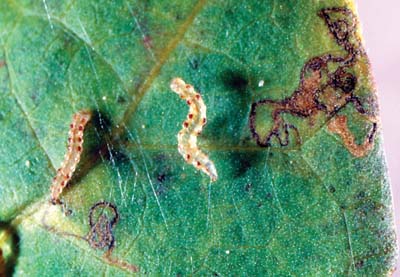
Morningglory leafminer, Bedellia somnulentella, larvae with
mines.
(Photographer: J. Capinera, University of Florida)
The only vegetable crop that is attacked by the morningglory leafminer is sweetpotato. Weed hosts include bindweed and morningglory. Mining the foliage by the larvae results in long tunnels that wind over the surface of the leaf and cause damage. The tunnels are located just below the epidermis of the leaf. If infestations are heavy, leaves may become withered or have a seared appearance. The morningglory leafminer is not considered to be a major pest in most conditions. Foliar insecticides may be applied to suppress morningglory leafminer populations.
Images
To save the Web-optimized images shown below to your hard drive:
|
Click to access Display and Print quality images. |